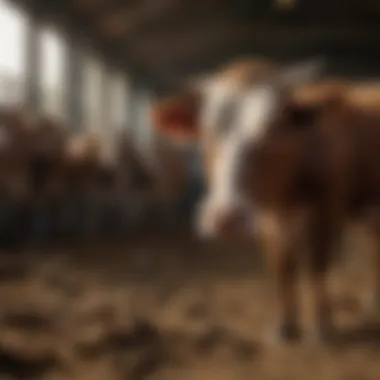GnRH's Role in Cattle Reproduction Management


Intro
Gonadotropin-Releasing Hormone (GnRH) plays a pivotal role in the reproductive health of cattle, guiding both dairy and beef industries toward more productive and efficient practices. Understanding this hormone allows agricultural professionals to make informed decisions that can significantly impact fertility rates and overall herd health. This narrative will take you through the essential concepts related to GnRH, its applications, and the latest advancements that are shaping reproductive management in cattle.
Through a comprehensive look at terminology, historical developments, and the current state of technology, we aim to shed light on how GnRH affects breeding practices. Let’s dive deeply into its implications for reproductive management, highlighting how this knowledge can aid farmers, livestock managers, and enthusiasts alike in optimizing their practices.
Prelims to GnRH
Gonadotropin-Releasing Hormone, commonly known as GnRH, serves as a linchpin in the reproduction systems of cattle. Understanding its functions and implications in reproductive management can significantly enhance livestock productivity and overall herd health. With the industry setting its sights on increasing fertility rates and optimizing breeding practices, delving into GnRH offers several insights that go beyond mere academic curiosity. It's about practical applications and the broader impacts on agricultural outputs.
The relevance of GnRH in cattle cannot be overstated. Not only is it central to the hormonal regulation of reproduction, but it also provides farmers and veterinarians with tools for managing breeding programs more effectively. Higher productivity often translates to substantial economic gains, reinforcing the need for a thorough comprehension of this hormone.
Moreover, as technology evolves, so too does our understanding of how hormonal treatments can correlate with animal welfare and ethical practices. Thus, the introduction of GnRH touches upon aspects of animal management, ethical considerations, and ultimately the sustainability of livestock farming. Recognizing the diverse ramifications associated with GnRH will equip farmers and stakeholders with knowledge essential for navigating the complexities of cattle reproduction and management in today’s agricultural landscape.
What is GnRH?
GnRH is a peptide hormone produced in the hypothalamus that functions as a primary regulator of the reproductive endocrine system. It plays a key role in initiating the release of two other hormones: luteinizing hormone (LH) and follicle-stimulating hormone (FSH). These hormones are vital for stimulating the reproductive processes in both males and females.
When released into the bloodstream, GnRH travels to the pituitary gland, prompting the secretion of LH and FSH. This ripple effect is critical; without GnRH, the reproductive cycle cannot properly function, leading to issues like poor fertility rates, irregular heat cycles, and even difficulties in parturition. Therefore, understanding GnRH is essential for grasping how these hormonal relationships influence overall reproductive health.
Historical Context of GnRH Research
The timeline of GnRH research dates back to the late 20th century, sparking interest due to its foundational role in reproductive endocrinology. Initial discoveries in the 1970s shed light on its structure and mechanism, paving the way for further studies that explored its bind to receptors across various species.
As scientific methodologies expanded, so did the focus on its applications in livestock. Researchers began to investigate ways this hormone could be harnessed to enhance breeding efficiency, ultimately leading to protocols that synchronize estrus and optimize artificial insemination procedures. Looking back on these pivotal moments in research not only reveals the trajectory of scientific inquiry but also underscores the enduring significance of GnRH in advancing livestock production practices today.
Importance in Livestock Production
The importance of GnRH in livestock production cannot be summed up in a few words. It is a key player that can influence various aspects of breeding management, making it integral for farmers aiming to improve herd performance.
- Synchronization of Estrus: GnRH is widely used in synchronization protocols to ensure that a group of cows comes into heat around the same time. This maximizes the chances of successful insemination and helps streamline breeding schedules.
- Artificial Insemination (AI) Success: In AI procedures, administering GnRH can significantly improve conception rates. By effectively timing AI to coincide with ovulation, producers can ensure higher fertility rates.
- Fertility and Health Link: Cattle with efficient GnRH signaling tend to maintain better reproductive health, leading to enhanced longevity and productivity in the herd. Mismanaged GnRH levels can result in a cascade of issues that may affect not only reproduction but overall dairy or beef production outcomes as well.
Physiology of GnRH in Cattle
Understanding the physiology of Gonadotropin-Releasing Hormone (GnRH) in cattle is essential for any producer or researcher aiming to optimize reproductive management. This section discusses the key elements that contribute to the effective utilization of GnRH, the benefits it brings to reproductive performance, and the physiological considerations underlying its functionality. As cattle producers strive for greater efficiency and productivity in the industry, grasping the nuances of GnRH physiology becomes imperative.
Synthesis and Secretion Mechanisms


GnRH is produced primarily in the hypothalamus, a small but crucial part of the brain. The synthesis of GnRH occurs in specialized neurons, which then release this hormone into the portal circulation leading to the anterior pituitary gland. Once in the anterior pituitary, GnRH stimulates the secretion of two key hormones: luteinizing hormone (LH) and follicle-stimulating hormone (FSH). These hormones play a pivotal role in regulating ovarian and testicular functions.
The secretion of GnRH itself is pulsatile; this means that it is released in bursts rather than continuously. The frequency and amplitude of these pulses can significantly influence the patterns of LH and FSH secretion. For example, higher pulse frequencies tend to favor the secretion of LH, which is necessary for ovulation. Understanding these dynamics helps in tailoring reproductive protocols that maximize fertility outcomes.
GnRH Receptors: Function and Distribution
GnRH functions via specific receptors found throughout the body, with the highest concentrations located in the pituitary gland. These GnRH receptors are critical because they translate the hormonal signals into biological actions. The presence of these receptors is not limited to the reproductive organs; they are also found in other tissues, including the brain and even the immune system, suggesting a more extensive role for GnRH beyond reproduction.
The activation of GnRH receptors triggers a cascade of intracellular events leading to the release of LH and FSH from the pituitary gland. Importantly, variations in receptor density and sensitivity can affect the responsiveness to GnRH. Therefore, understanding receptor distribution and function aids in improving breeding management practices through targeted hormonal treatments.
Role in the Reproductive Hormonal Cascade
The contribution of GnRH to the reproductive hormonal cascade is indispensable. Once secreted, its primary action is on the anterior pituitary to stimulate LH and FSH production. These hormones, in turn, regulate processes such as follicular development, ovulation, and luteinization in females, as well as spermatogenesis in males.
It's important to note how critical timing and synchronization are in this hormonal cascade. For instance, the proper administration of GnRH can be crucial during estrus synchronization protocols. By manipulating the timing of GnRH administration, producers can enhance the synchronization of estrus and optimize artificial insemination timing, dramatically improving overall fertility rates.
"The intricate dance between GnRH and other reproductive hormones underlines the complexity of cattle reproduction. Understanding this cascade is vital for making informed management decisions."
GnRH's Role in Breeding Management
Gonadotropin-Releasing Hormone (GnRH) has carved out a pivotal position in modern cattle breeding management. By influencing the intricate pathways of reproduction, it assists producers in optimizing herd fertility, improving calving rates, and aligning breeding schedules with market needs. Using GnRH effectively within breeding protocols can lead to significant advancements in productivity, which is precisely why it deserves a thorough exploration.
GnRH in Estrus Synchronization Protocols
Estrus synchronization is arguably one of the most impactful applications of GnRH in cattle management. By administering GnRH in conjunction with progesterone, producers can manipulate the reproductive cycle, causing a group of cows to exhibit estrus at roughly the same time. This synchronization allows for concentrated breeding efforts, significantly enhancing the likelihood of timely pregnancies.
In practical terms, some common protocols consist of using GnRH injections on day zero, followed by a controlled release of progesterone. After a set period, a second GnRH injection prompts ovulation—all cows are then bred within a narrow time window. The resultant 'all-in-all-out' approach not only saves time but ensures that herd management is more efficient. As a result, producers can see quicker return on investment and potentially improve overall herd genetics by managing breeding more strategically.
Application in Artificial Insemination Procedures
Artificial insemination (AI) is another area where GnRH proves to be invaluable. When cows are synchronized in their heat cycles, AI timing can be executed with far greater precision. The introduction of GnRH aids in ensuring that ovulation occurs at a desired time, allowing AI technicians to deposit semen right when the ovum is most receptive.
For instance, consider a herd where ovulation timing fluctuates; this unpredictability can lead to wasted semen or missed opportunities for breeding. But with the application of GnRH, technicians create a primary window for AI that aligns closely with the ovulation cycle of the heifers or cows. This targeted approach can notably enhance the conception rates—especially in conditions where natural breeding is a challenge.
Impact on Fertility Rates
Ultimately, the impact of GnRH on fertility rates cannot be overstated. Several studies have indicated that effective GnRH utilization can lead to increased pregnancy rates and shorter intervals between calving. This not only benefits the producers' bottom line but also contributes positively to the overall health of the herd.


A report from agricultural research centers has shown that herds utilizing GnRH protocols experience improved fertility rates by around 10-15% when compared to those employing traditional methods. This increase can directly affect the profitability of dairy or beef operations, allowing for an efficient cycle of birth and growth that meets commercial demands.
“Optimizing breeding schedules with GnRH can change the game in cattle farming, turning challenges into opportunities.”
In essence, the thoughtful implementation of GnRH in breeding management streamlines processes, enhances fertility rates, and improves the economic viability of cattle farming at a large scale. As the emphasis on efficiency and profitability continues to rise within the agricultural landscape, harnessing the true potential of GnRH will likely become a cornerstone strategy for many producers.
Current Research and Innovations
Research in the field of Gonadotropin-Releasing Hormone (GnRH) is crucial for advancing cattle reproductive management. This section delves into the latest findings and innovative approaches aimed at optimizing breeding outcomes and enhancing overall herd productivity. Understanding these elements is essential for farmers and livestock managers looking to stay ahead in a competitive agricultural landscape. In particular, recent studies highlight the role of GnRH not only in improving fertility rates but also in addressing issues such as labor efficiency and resource management.
Recent Findings on GnRH and Ovulation Timing
Recent studies suggest that GnRH plays a vital role in synchronizing ovulation, making it a key target for reproductive interventions. The relationship between GnRH administration and timing of ovulation is a subject of intense scrutiny. Researchers have discovered that precise timing of GnRH injections can significantly impact the ovulation response in cattle. This means that proper scheduling of hormone treatments can lead to enhanced conception rates.
For instance, a study published in the Journal of Animal Science indicates that administering GnRH at specific points in the estrous cycle amplifies the likelihood of successful ovulation within the desired timeframe. Farmers adopting these timed protocols can strategically plan breeding and improve overall efficiency.
"Precision in GnRH treatment is shifting the landscape of cattle reproduction."
Exploration of Novel GnRH Analogues
The exploration of novel GnRH analogues reveals exciting prospects in reproductive science. Recent innovations have led to the development of synthetic variants that demonstrate improved efficacy compared to naturally occurring GnRH. These analogues can offer extended biological activity or altered receptor selectivity, which may help overcome challenges seen in traditional treatments.
Researchers are particularly excited about compounds such as Triptorelin, which exhibits a longer half-life and enhanced stimulation properties. Such developments allow for less frequent dosing and potentially decrease stress on the animals, aligning with animal welfare standards. The ongoing exploration of these analogues promises more targeted approaches to reproductive management, making them invaluable to livestock producers aiming to achieve higher reproductive success.
Impact of Genetic Considerations
Genetic factors also play a significant role in the response to GnRH treatments. Recent research has highlighted that the genetic makeup of cattle can influence the effectiveness of hormonal protocols. Understanding these genetic predispositions can empower farmers to tailor their reproductive strategies according to the specific characteristics of their herd.
This area of research may lead to the identification of genomic markers associated with favorable responses to GnRH, allowing for selective breeding practices that enhance reproductive traits. Such advancements not only improve breeding efficiency but also contribute to better herd management practices overall. As these genetic insights become more widely accessible, they can provide farmers the tools needed to make informed breeding decisions that align with their operational goals.
Ethical Considerations Surrounding GnRH Use
The use of Gonadotropin-Releasing Hormone (GnRH) in cattle has brought about significant advancements in reproductive management. However, alongside these benefits arises a critical need for discussions surrounding the ethical implications of its application. This section delves into the various dimensions of ethical considerations, ensuring that while we leverage modern biotechnologies for productivity, we do so with caution and empathy.
Animal Welfare Concerns
First and foremost, animal welfare should be at the forefront of any conversation regarding hormonal treatments in livestock. When administering GnRH or any similar treatments, it is vital to consider the potential impacts on the animals' well-being. Concerns often center around the stress associated with hormone treatments and the methods used for administration, which can vary.


Some might argue that the stress of handling and injecting cattle can outweigh the potential benefits of improved reproductive efficiency. Thus, it's crucial to implement practices that minimize stress during such procedures. This can include:
- Using proper handling techniques to reduce anxiety
- Ensuring the health and comfort of the animals during treatments
- Training staff adequately in animal handling and administration protocols
Moreover, research continues to reveal how repeated hormone administration can lead to unwanted physiological changes. Ensuring adherence to best practices will support not only the physical health of cattle but also their natural behaviors and inclinations.
Regulatory Framework for Hormonal Treatments
The regulatory environment surrounding the use of GnRH in cattle is also complex and varies significantly by region. In many places, authorities have established guidelines to ensure that hormone treatments are employed responsibly. Understanding these regulations is paramount for producers.
Legislation often mandates:
- A clear justification for hormone use in breeding programs
- Documentation of the treatments administered
- Monitoring of animal health post-treatment
Such regulations help maintain a check on practices that may compromise animal welfare or public health. Encouraging transparency and adherence to these guidelines not only fosters consumer trust but also promotes sustainable agricultural practices.
Public Perception and Acceptance
Public perception plays a crucial role in the broader acceptance of hormonal treatments in agriculture. With increasing awareness about food production systems and animal welfare, consumers are more informed and concerned about how livestock are treated. This growing concern necessitates transparent communication from producers regarding their practices.
To build public trust, farmers must:
- Share information about how GnRH and similar hormones improve fertility and animal health
- Address misconceptions or fears surrounding hormone use openly
- Engage in community discussions to articulate the positive impacts on animal breeding and overall productivity
As awareness spreads, it’s vital for the agricultural sector to remain proactive in addressing ethical concerns, aligning practices with consumer expectations while emphasizing the significance of proper management of livestock.
"Ethics isn't about what we can do; it’s about what we should do." - Unknown
In summary, while GnRH presents numerous advantages in cattle reproduction management, it is essential to weigh these benefits against ethical considerations. Attention to animal welfare, robust regulatory frameworks, and public perception will ensure that the use of hormonal treatments in agriculture not only contributes to productivity but also aligns with ethical farming practices.
Closure
In this analysis, we’ve explored the multifaceted role of Gonadotropin-Releasing Hormone (GnRH) in cattle reproduction. Understanding GnRH extends beyond mere science; it touches on the efficiency, productivity, and overall welfare in livestock management. The implications of GnRH applications are vast, significantly altering breeding practices and enhancing reproductive performance.
Summary of Key Insights
- Central Role of GnRH: GnRH serves as the pivotal trigger for the reproductive hormone cascade, ultimately leading to ovulation. The synthesis and secretion of this hormone are critical for maintaining reproductive cycles in cattle, impacting not just individual animals but entire herds.
- Breeding Management Impact: The application of GnRH in protocols for estrus synchronization and artificial insemination demonstrates its ability to streamline breeding processes. Farmers can achieve more precise timing in mating, which often translates to improved fertility and cost-efficiency.
- Ethical Considerations: While the benefits are glossy on the surface, we cannot overlook the ethical dilemmas. The use of hormonal treatments raises issues around animal welfare and public acceptance. A balanced approach that considers these aspects alongside productivity is necessary for sustainable agricultural practices.
- Ongoing Challenges: The evolving landscape of genetic considerations and novel research emphasizes the need for continued learning and adaptation. The interplay between genetics, environment, and hormonal interventions creates a complex web that researchers and practitioners must navigate.
Future Directions in GnRH Research
Looking ahead, several avenues present themselves for exploration in GnRH research:
- Refining Treatments: Investigating novel GnRH analogues could usher in new treatments that enhance reproductive outcomes while minimizing side effects.
- Precision Agriculture: Integrating GnRH management into precision agriculture practices may optimize resource use and improve reproductive efficiency further.
- Public Perception Studies: Understanding public sentiment toward hormonal treatments can help shape future policies and practices in livestock production.
- Cross-Disciplinary Research: Collaboration across various fields, including veterinary science, animal ethics, and agricultural technology, will be crucial in developing innovative solutions to existing challenges.
The study of GnRH in cattle not only unveils a crucial aspect of reproductive health but also serves as a beacon guiding future research and practices in agriculture. As we move forward, striking a balance between productivity and ethical considerations will be vital for the advancement of the field.















